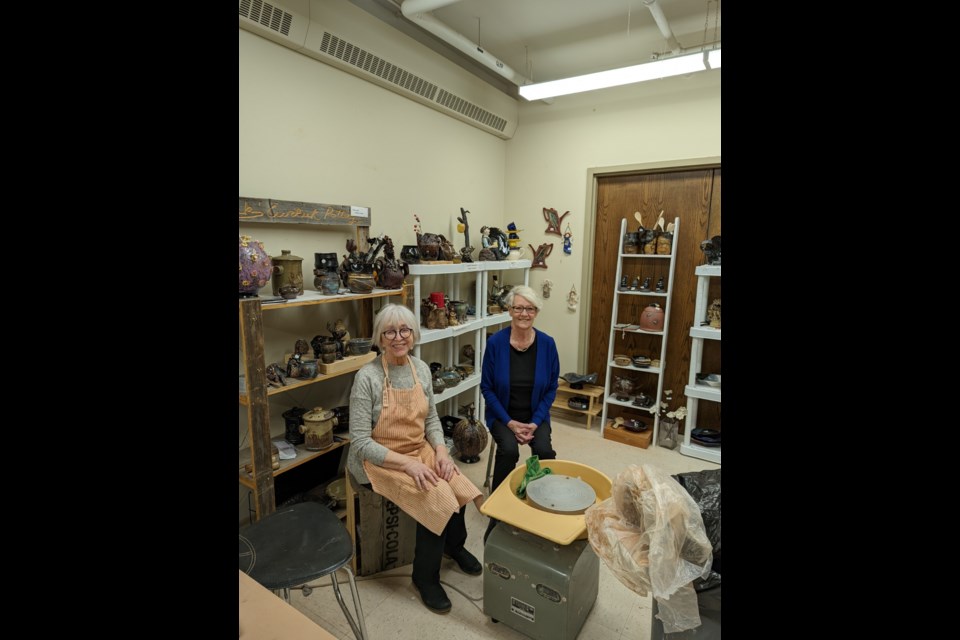Dorothy Yakiwchuk and Kathy Verbeke are Saskatchewan artists who have joined forces in their studio at the Moose Jaw Cultural Centre. The “Mud Pie Girls” have been together for about five years now.
The name of their collaboration comes from Verbeke’s husband, referring to their pottery.
“He would come in and say, ‘Are my mud-pie girls here?’” Verbeke laughs merrily.
“He would ask, ‘Are you working, mud-pie girls?’” Yakiwchuk adds.
Both Verbeke and Yakiwchuk have had long, successful careers. Yakiwchuk says she knows exactly how long she’s been a professional artist because she began while pregnant with her second baby.
“I always know how long I’ve done this, because (my son) is now 47,” she says. “And I was frustrated, waiting for him to be born. And they had these church ‘mornings out,’ where you could leave your children and you could go learn a craft. The only thing that was open was pottery. Nobody had registered for pottery. So I said, ‘I like art – I like any kind of art. I’m gonna try that.’ And I never stopped.”
Yakiwchuk decided to go to art school in Fort Qu’Appelle, and her husband supported her. He took care of the kids, and she finished school and turned her passion into her work.
Originally from Manchester, England, Verbeke describes her start as an artist as a somewhat practical decision: “I needed a job when I came to Saskatchewan. I had done a little bit before, but … I was out in the country, on the farm, so I knew I had to do something. So I went and took pottery lessons, and I bought a wheel, and I learned how to use it.”
However, the Mud Pie Girls agree that while their start might have come from wanting a career and something to do with their time, “art is soul.”
“Art is passion, it really is. It’s very ‘soul,’” Yakiwchuk says, while Verbeke nods in agreement. They say it can be very personal and vulnerable because you expose part of yourself in your art. Then, that art is put on display for the judgment of others.
One of the reasons they’re happy to be collaborating together is that their studio is a safe, encouraging, non-competitive space. They started renting it about five years ago.
Yakiwchuk says they’ve known each other even longer than that – without realizing.
“It’s quite interesting, I think, how we came together not knowing that we’d known each other – we’d been at different art shows together, oh, many times over the years, in the province. And maybe our booths weren’t even that far apart,” Yakiwchuk says.
Nevertheless, they didn’t become close friends until they were both mentoring at the Moose Jaw Pottery Club — which they wholeheartedly endorse as a place to learn the craft.
Yakiwchuk was on the Cultural Centre’s board at the time and they were about to have an exhibition in the Mosaic Gallery — then, it came up that there was a studio space for rent.
“How long did it take us to decide?” Yakiwchuk asks Verbeke.
“About two minutes,” Verbeke laughs.
“You know, it was just one of those wonderful moments of, what do you call it? Serendipity,” Yakiwchuk says.
“And we’re both in the same age group,” Verbeke adds. “And we can come in when we feel like it, and we can stay home when we feel like it. So it works pretty good.”
They are both semi-retired now, meaning they can produce the art they want. Verbeke says that when they were focused on making a living, a lot of time needed to be spent maintaining inventory.
“It’s your work. If you’re going to a show, you better have enough stuff.”
COVID has been a discouraging interruption of their rhythm. There was even a period of about three months where they didn’t come into the studio – both for lack of customers and because of safety concerns.
Yakiwchuk says that the arts suffer first in difficult times. They’re thrilled that the pandemic seems to be ending, and they can spend more time together. They’ve always gotten along easily.
“I didn’t see much of an adjustment that we ever had as to coming together and sharing a space,” Yakiwchuk says. “We’re just encouraging of each other and rejoicing with each other in what we’re doing.”
The Mud Pie Girls love the Cultural Centre, saying they’re taken care of and appreciated. They have a permanent alcove in the gallery for their sculptures and stoneware, and a wall for their paintings.
Head down to the Cultural Centre to see their work. Some of it is practical, some for display – and each piece reflects a lifetime of passion and mastery of craft.




